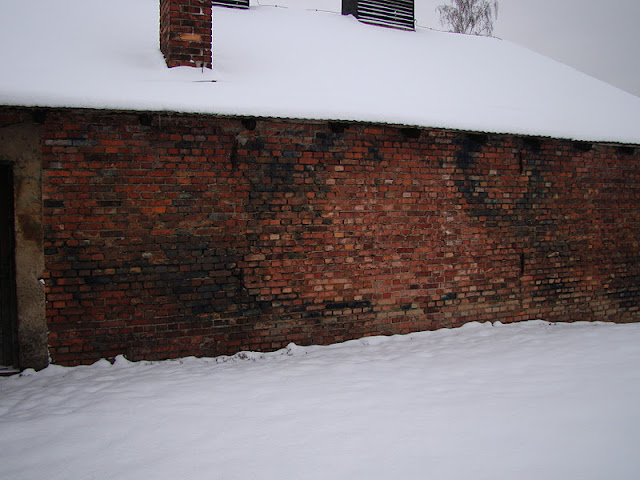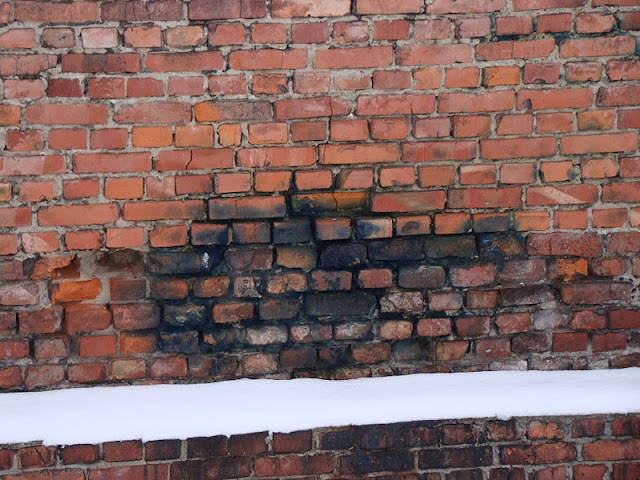 |
| Former SS Administration building at Auschwitz-Birkenau, now a church. The building is outside the museum grounds, across a public road. I did walk over to have a look behind the building, but there are signs at the gate to the car-park (on the right of the building) stating "Private Property." But Google Earth shows there's not much to see behind it anyway. |
Wednesday, 25 January 2012
Auschwitz 2: SS Admin Building
Auschwitz: Central Construction Office
In his judgment of the 2000 libel trial of Irving vs.
Penguin & Lipstadt, Justice Gray stated:
The most important Auschwitz archive that survived the war was that of the Central Construction Office at Auschwitz. The main archives of the camp Kommandantur had been destroyed by the Germans before they evacuated the camp in January 1945. The Construction Office was 300 yards away and through an oversight was left intact.
- Judgment 7.58
Leading Revisionist Carlo Mottongo states (in the above mentioned book pp.7-8) that the Soviets took back to Moscow over 88,000 documents from the Auschwitz Central Construction Office, and although this was the greater share of the documents found in the office building of the Central Construction Office, many documents remained there.
I enquired as to the location of the premises of the Auschwitz Central Construction Office" aka the "ZBL" (Zentralbauleitung) at the Information Desk in the Auschwitz Visitor Centre. The young lady at the desk did not know, so she asked her supervisor, who didn't know either. She then asked two Auschwitz tour guides, neither of them knew where it was, but all of them were very friendly and immensely helpful. Finally, one of the tour guides took the piece of paper on which I'd written "Central Construction Office. ZBL", and headed off behind a "staff only" door. After 5 minutes he returned and advised that: "It is no more, demolished after the war, houses are there now." But he kindly gave me directions to where it once had approximately stood.
 |
| Photo taken at the position marked "A" on the above google earth view of the road on which the office of the Central Construction Office stood |
 |
| Another house along the same segment of road |
Labels:
Auschwitz I,
Auschwitz II,
Birkenau
Auschwitz 2: Selection Ramp
 |
| Photo of the selection ramp in Block 4 of Auschwitz 1 |
 |
| The eastern-end of the ramp is to the left of the set of rails on the left of the photo |
| Location of the unloading ramp Auschwitz-Birkenau |
 |
| Cattle-cart in which Jews were taken to Auschwitz-Birkenau, looking good for 70+ years old |
 |
| Looking north up the road which runs between Compounds B2D (left) and B2C |
| Position photo was taken |
 |
| Sign reads: Jews selected by the SS for Immediate death in the Gas Chamber of Crematoria IV and V were herded along this road Photo taken by the SS, 1944 |
Labels:
Auschwitz II,
Birkenau,
death train tracks
Auschwitz 2: Guard Towers
There are two sorts of guard-towers at Auschwitz-Birkenau, both made of wood, so obviously none of them are original. The better of the two, look exactly the same as the guard-towers in Auschwitz I, whilst the other sort look comical.
 |
| Did the Nazis kill people by forcing them to attempt to climb in these guard-towers? |
 |
| The road along the eastern-edge of the Birkenau camp |
Auschwitz 2: Section B2G: Canada 2
| Compound B2G nicknamed Canada II |
In the 1996 edition of Death Dealer: The Memoirs of the SS Kommandant at Auschwitz Rudolph Höss, footnotes added to "Rudolph Hoess' original text" by Steven Paskuly read:
33. There were two Canadas. Canada I was near the Auschwitz camp, Canada II was located outside the barracks area across from the sauna and shower building on the west side of the Birkenau camp. The term Canada was coined by the prisoners because the nation of Canada meant wealth and prosperity. ...
35. Canada II consisted of thirty-five barracks. On January 23, 1945, five days before the liberation of the camp by the Soviet army, the SS set fire to thirty storehouses crammed full with the property of the murdered millions. The barracks burned for several days. In six of the partially destroyed barracks 1,185,345 men's suits and women's outfits, 43,255 pairs of shoes, 13,694 carpets, and huge quantities of hairbrushes, shaving brushes, and other articles used in everyday life were also found.
Rudolph Höss. Edited by Steven Paskuly. Translated by Andrew Pollinger. Foreword by Primo Levi. Death Dealer: The Memoirs of the SS Kommandant at Auschwitz Rudolph Höss. Da Capo Press, Massachusetts. 1996. p. 40.
 |
| Looking eastwards at the Canada II section, behind me was the Central Sauna |
 |
| Museum sign for Canada II |
| Enlargement |
 |
| Museum sign at Canada II |
| Enlargement |
 |
| In the remains of Block 5 of Canada II is a collection of goods stolen from Jews |
 |
| Evidence of the Holocaust inside the display at Block 5 in Canada II |
Labels:
Auschwitz I,
Auschwitz II,
Birkenau,
Canada I,
Canada II
Auschwitz 2: The Pond of Ashes
 |
"The pond of ashes" to the right is Krema 4.
..
Jacob Bronowski famously claimed in 1973:
"Into this pond were flushed the ashes of some four million people."
..
In 1996 Alan Jacobs claimed:
"Into this pond were dumped the ashes of many tens of thousands of people,"
|
 |
| In the memory of the men, women, and children who fell victim to the Nazi genocide In this pond lie their ashes May their souls rest in peace |
Labels:
Auschwitz II,
Birkenau
Tuesday, 24 January 2012
Auschwitz 2: BW 5a: Blue Stains
The museum sign for Compound B1B claims that the above circled building: BW 5a (BW is an abbreviation of Bauwerken, which translates to Building) was "Showers", but the building also had other purposes, it was where prisoners' clothing and bedding was treated with Zyklon B to kill lice. Unlike any of the seven "homicidal gas chambers" at Auschwitz I and Auschwitz-Birkenau, this building has the tell-tales signs that in came into contact with vast quantities of hydrocyanic gas = Prussian Blue staining
 |
| South wall of delousing chamber |
 |
| South wall of delousing chamber |
 |
| North wall of delousing chamber |
 |
| North wall of delousing chamber |
 |
| North wall of delousing chamber |
 |
| East wall of delousing chamber |
 |
| East wall of delousing chamber |
Labels:
Auschwitz II,
BIa,
Birkenau
Subscribe to:
Comments (Atom)












